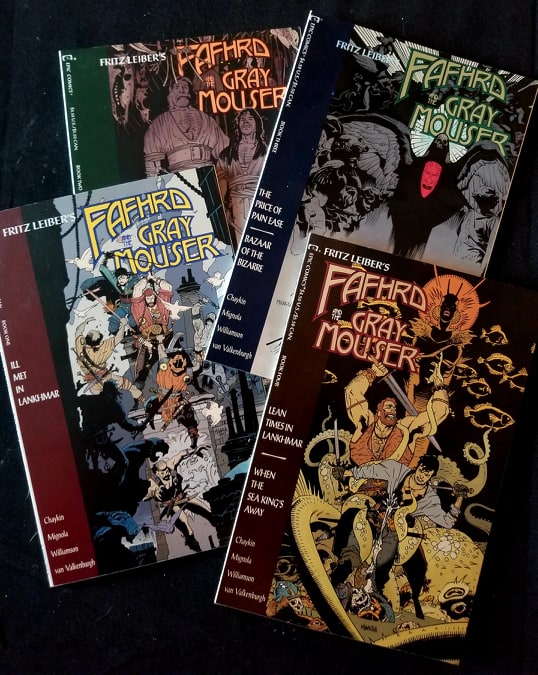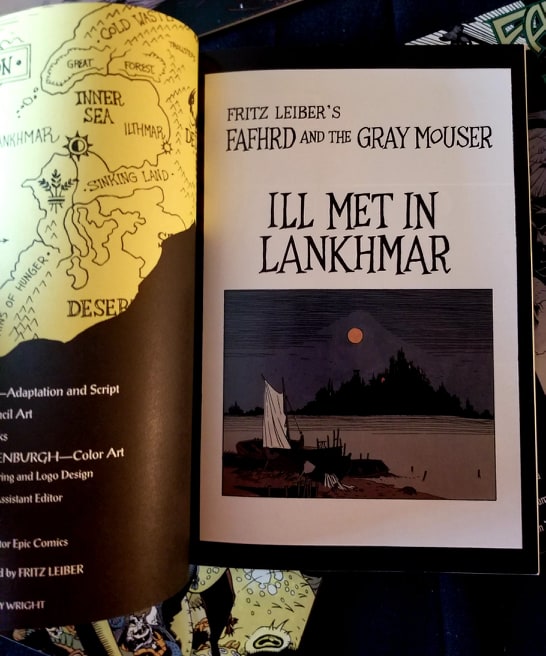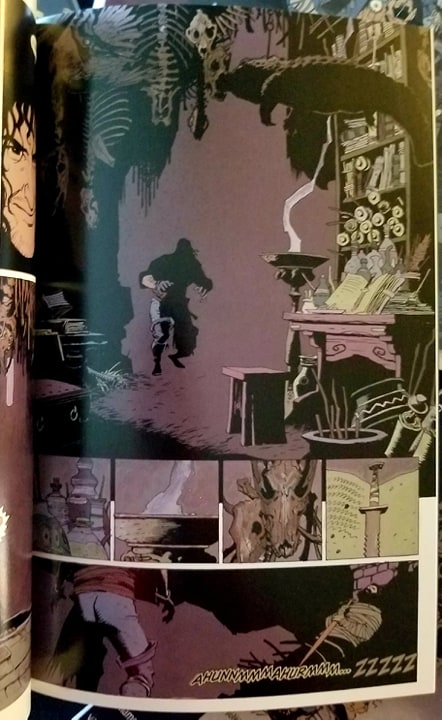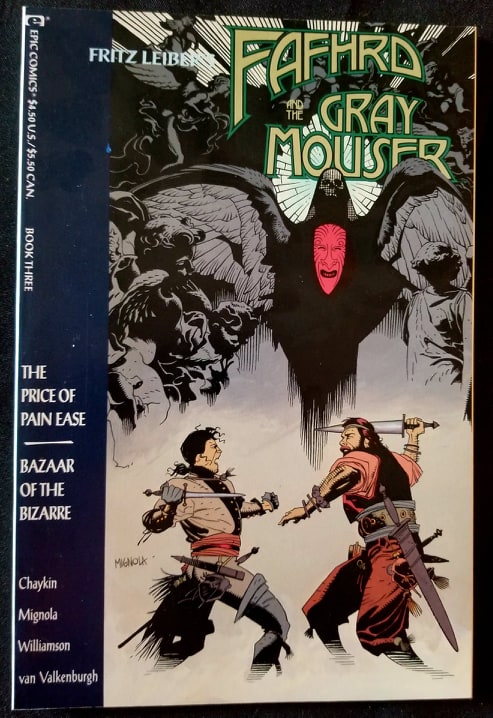
Based On Characters Created By: Fritz Leiber & Harry Otto Fischer
Scripted By: Howard Chaykin
Pencils: Mike Mignola
Inks: Al Williamson
Colors: Sherilyn Van Valkenburgh
Letters: Michael Heisler
Publisher: Epic Comics
Available: Collectors’ market only; either eBay or fantasy-adventure long-boxes
Price: If you can find them, probably $4-10 per issue, depending on condition and your bargaining prowess…
This week’s journey into yesteryear takes us to yet another sword & sorcery line (I know, a bit of a theme with me—I promise, this is the last one…at least until next time), the Epic Comics 1990-91 rendition of Fritz Leiber’s classic low-brow/high-fantasy characters, Fafhrd and the Gray Mouser.

Fritz Leiber (1910-92) created hulking northerner Fafhrd and diminutive burglar Gray Mouser (loosely based on Leiber and friend/collaborator Harry Otto Fischer themselves) after a period of interaction with H.P. Lovecraft in 1939. Stories of the two not-really-heroes spanned Leiber’s career, from his first published story in ‘39 to his death in 1992. The brotherly if ill-matched bravos meandered the streets of Lankhmar and the broader continent of Nehwon seeking adventure, opportunities to carouse and sow chaos, and occasionally perform the accidental good deed. In their travels, they found themselves under the semi-willing patronship of Ningauble of the Seven Eyes and Sheelba of the Eyeless Face (quite possibly fantasy’s first transgender wizard) and interacted with a host of support characters of all sort and savor. A reaction against the more idealized heroes of Edgar Rice Burroughs and Robert E. Howard, the characters, and the city of Lankhmar, have influenced fantasy adventure literature, role-playing games and even comic books since their first publication.
Within the comic world, Fafhrd and the Gray Mouser first appeared in the pages of Wonder Woman #202 in 1972 before segueing into their own short-lived (five issues) DC title, Sword of Sorcery (which featured Howard Chaykin as artist) in 1973; Dark Horse released a trade collection of the series in 2008. The characters also made appearances in Marvel’s Conan the Barbarian series, under the names Vangheim and Blackrat; series writer Roy Thomas made no bones about the pair being a Leiber homage.
The Epic series (which experienced a now-difficult-to-find trade treatment by Dark Horse in 2007) presents a number of the classic Leiber shorts, typically two to a book, in chronological progression. Issue one covers “Ill Met in Lankhmar”; issue two offers “The Circle Curse” and “The Howling Tower”; three presents “The Price of Pain Ease” and “Bazaar of the Bizarre”; and four gives us “Lean Times in Lankhmar” (my personal favorite) and “When the Sea King’s Away.” Essentially, we witness the characters’ meeting, their mutual loss of their beloveds, their travels through Nehwon and ultimate patronage to Ningauble and Sheelba…and some fun side-stories. While there’s a great deal of material the series did not hit upon (such as the bravos’ growth into responsible, married men), the selections are an excellent sample of Leiber’s work, and feature some of the most groundbreaking fantasy stories of their era.
Oh, and I should probably mention they’re outstanding comics.
Chaykin, clearly a Leiber-ite (having drawn much of the DC series twenty years before), effortlessly translates the source work to the graphic format. One of the things I love most about the original Leiber material is its tone; there’s an undercurrent of dark humor throughout the series, melded with just enough heart to make these arrogant criminals lovable (think a lower-key Deadpool, wearing a jerkin and set 400 years ago). A less-able writer would have missed this—or mixed up the cynical burglar’s hidden romanticism, or the brash brawler’s deeper philosophy. Chaykin, though, delivers: the characters read just as I’d experienced them in the books.

And, thanks to a pre-Hellboy Mike Mignola, they look just like them, too.
As might be intuited from my Thieves’ World review (which can be found here), I enjoy tracking down my favorite artists’ earliest works, observing their development from nascent pencillers or inkers to the styles and achievements they’re known for today. While this isn’t Mignola’s earliest work (which was actually with Marvel in the early 1980’s on Daredevil and Power Man & Iron Fist), Fafhrd and the Gray Mouser does present a great deal of the style—the use of black space and shadow, unusual angles, stylized presentation and frequent use of symbolism—that would become trademarks of Hellboy three years later. This style is an ideal fit for Leiber’s work, echoing all the shadow and view askance that characterize Lankhmar.

Williamson’s inks and Van Valkenburgh’s colors are also perfect fits, accentuating Mignola’s lines and again, capturing the essence of Nehwon (oh—read that backwards, by the way—Leiber was a sneaky gent—though he stole the idea from Samuel Butler). And Heisler’s lettering is an achievement, merging frequently into Mignola’s artwork, as much a part of the scene as any figure or weapon.

The action captures all the grace of Mouser’s catlike style, and the bashing barbarism of Fafhrd’s northern roots—while the creeping shadows convey all the dank alleyways and fetid laboratories of Lankhmar’s darker corners.
All of the action, the shadow, the philosophy, the dark, dark humor that is Fritz Leiber at his best, all in four tidy and attractive comics. An absolute shame that Epic apparently didn’t make enough coin on them to make more, but a healthy chunk of happiness to enjoy nonetheless, and a nice preview to the great creator that Mike Mignola was on his way to becoming.
Like a lot else from our bookshelf reviews, finding copies of Fafhrd and the Gray Mouser might prove an adventure worthy of the boys themselves. Your best bet is to search the fantasy and Mignola boxes at your local comic shop or convention, or take the easy way and do a search on eBay. You ought to be able to (eventually) find them in the neighborhood of $4 to $10 a book, depending on condition; for whatever reason, they didn’t exactly take the collector’s market by storm. Definitely worth the time and money, in any regard.

Or if you ask really, really nice, and maybe throw in a slice of cinnamon pie, I’ll loan you mine.
Score: 13/13
Review by Andy Patch, thePullbox.com




